本文由 dhk Architects 授权mooool发表,欢迎转发,禁止以mooool编辑版本转载。
Thanks dhk Architects for authorizing the publication of the project on mooool, Text description provided by dhk Architects.
dhk Architects:巴特利公园是一个12000平方米的新城市公园,位于非洲最受欢迎的旅游目的地之一——南非开普敦。该项目作为该地区城市发展的核心,包括一个公园和一个广场,它有效地隐藏了海湾的1 206个停车场设施,创造了新的步行路线,给该区域重新带来了活力。该场地还非常具有考古价值,因为它含有该城市最古老建筑之一的遗迹——沿海防御工事阿姆斯特丹炮台。这为建筑和城市设计公司dhk提供了一个独特的机会——在整合停车设施和提供休闲娱乐活动空间的同时,向这个历史地标致敬。
dhk Architects:Battery Park is a new 12 000 sqm (1.2 hectre) urban park situated at a key entranceway to one of Africa’s most visited tourist destinations, the V&A Waterfront in Cape Town, South Africa. Developed as the nucleus of a larger urban vision for the district, the site includes a park and piazza that effectively conceal a 1 206-bay parking facility as well as new pedestrian routes to invigorate the precinct with activity. The site is of archaeological importance as it contains the remnants of one of the city’s oldest structures, coastal fortification the Amsterdam Battery. This provided a unique opportunity for architecture and urban design firm dhk – to pay homage to the historic landmark whilst incorporating a parking facility and providing spaces for leisure and recreational activities.

该项目是dhk为V&A之前未得到充分利用的运河区创建的城市设计框架的一部分,该设计促进了历史城市中心和De Waterkant与V&A的重新连接,其目的是在众多新的步行路线的交汇处创建一个公共公园,将新区与周围的城市结构连接起来,从而帮助激活该区。阿姆斯特丹炮台是荷兰人在1784年沿着开普敦的海岸线建造的,目的是保护这座城市免受海上和陆地的攻击。在19世纪,这座建筑被用来关押囚犯;后来又被英国人改造和加强,但最终被抛弃。1905年,为了给连接港口的铁路让路,炮台被拆除,只留下一小部分曲面墙。历史遗迹现在坐落在新运河上方8米处,新的运河在较低的水平面上穿过遗址。
The project forms part of an urban design framework created by dhk for the V&A’s previously underutilised Canal District that facilitates the reconnection of the historical city centre and De Waterkant to the V&A. The aim was to create a publicly accessible park which lies at the nexus of a multitude of new pedestrian routes stitching the new district into the surrounding urban fabric and thereby helping to invigorate the area. The Amsterdam Battery was erected by the Dutch along Cape Town’s coastline in 1784 to defend the city from seaborne and land attacks. In the 1800s the building was used to house prisoners; and was later remodelled and strengthened by the British but eventually abandoned. In 1905 the battery was largely demolished to make way for railway connections to the port, leaving behind only a small portion of its rear curved walls. The historical remnants are now perched eight metres above the new canal running through the site at a lower level.
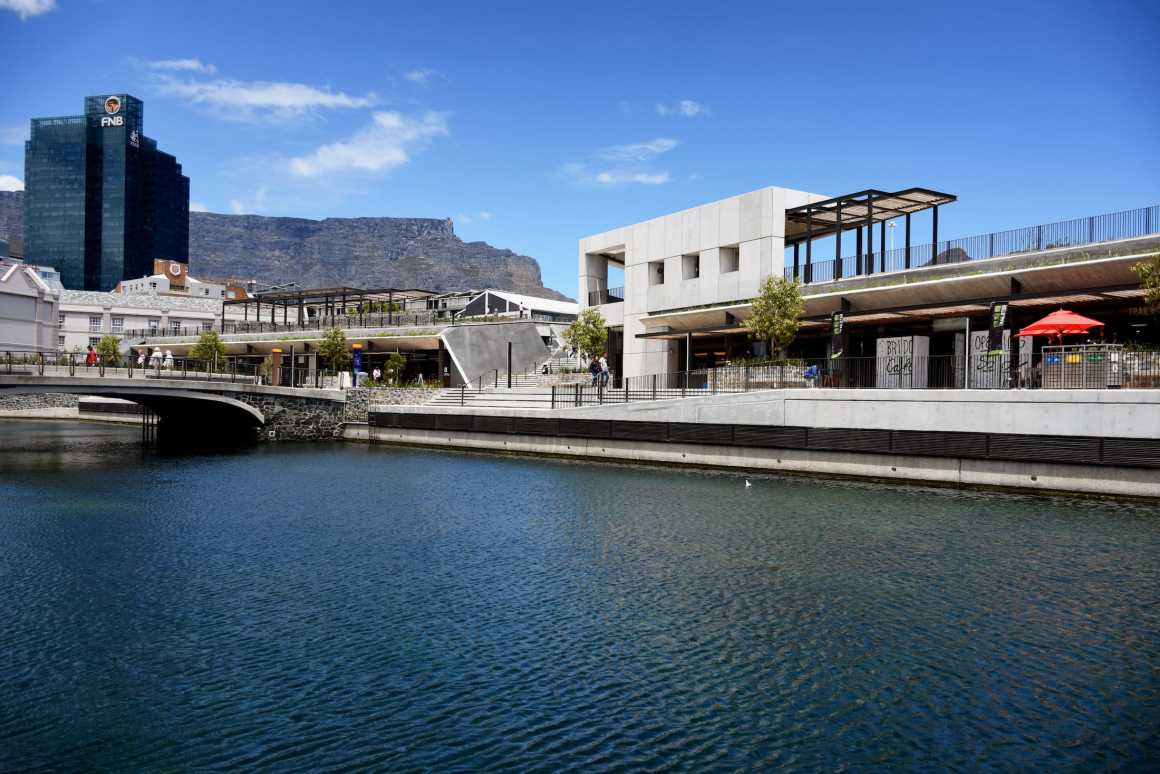
在炮台公园的建设过程中,考古发掘揭示了以前用于设计的原始数据。凸起的公园保持在炮台原有的内庭院水平,而广场上零售单元上方的种植边缘代表着炮台正面的自然地面水平。各种各样的建筑和景观元素反映了该建筑的原始足迹,如半圆形弯曲的道路,后城墙的混凝土添加物,八字形面向运河的墙和混凝土覆盖的结构,让游客真正感受到炮台原始的尺寸大小,开普敦信号山上正午炮的轴向视觉连接也被保留了下来,从而保持了该基地的历史视线。
During construction of Battery Park archaeological excavations revealed former datums which were used to inform the design. The raised park has been kept at the battery’s original inner courtyard level whilst planted edges above retail units on the piazza represent the estimated natural ground level that fronted the battery. Various architectural and landscaped elements reflect the structure’s original footprint, such as semi-circular curved pathways, concrete additions to the rear ramparts, splayed canal-facing walls and concrete-clad structures – giving visitors an authentic sense of the battery’s former size. An axial visual connection to Cape Town’s Noon Gun on Signal Hill has also been retained, thus preserving the site’s historic sightline.
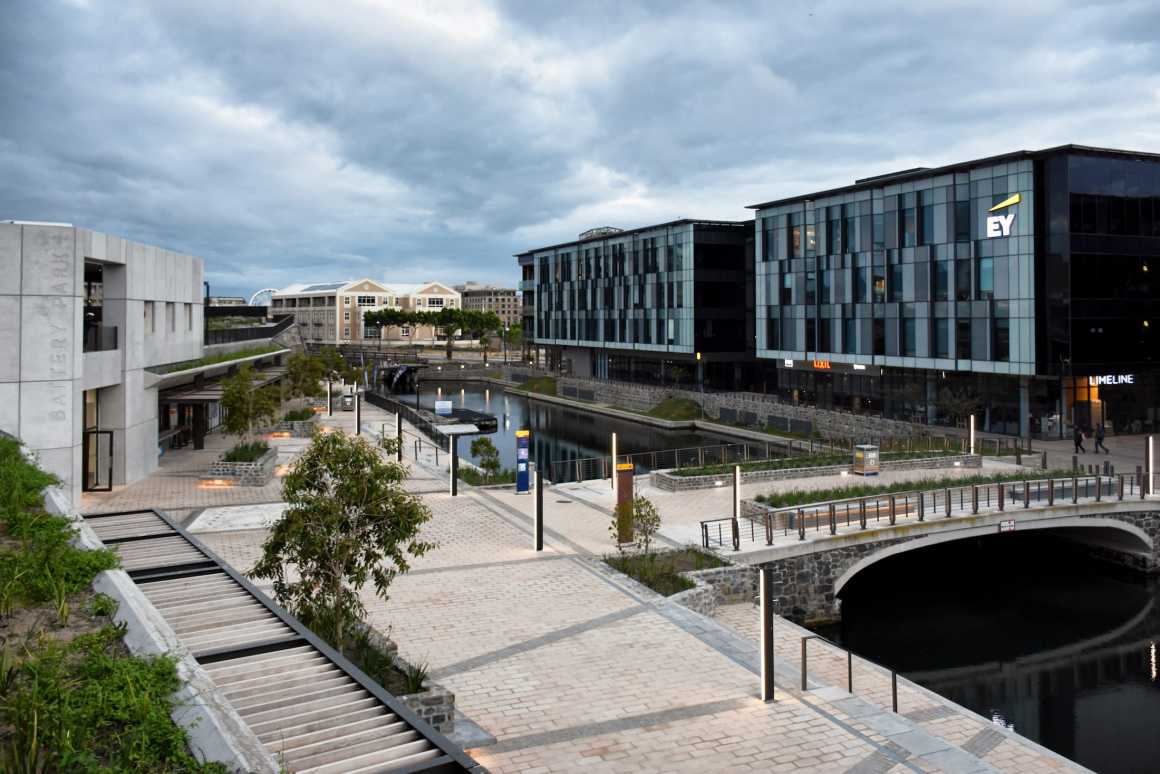
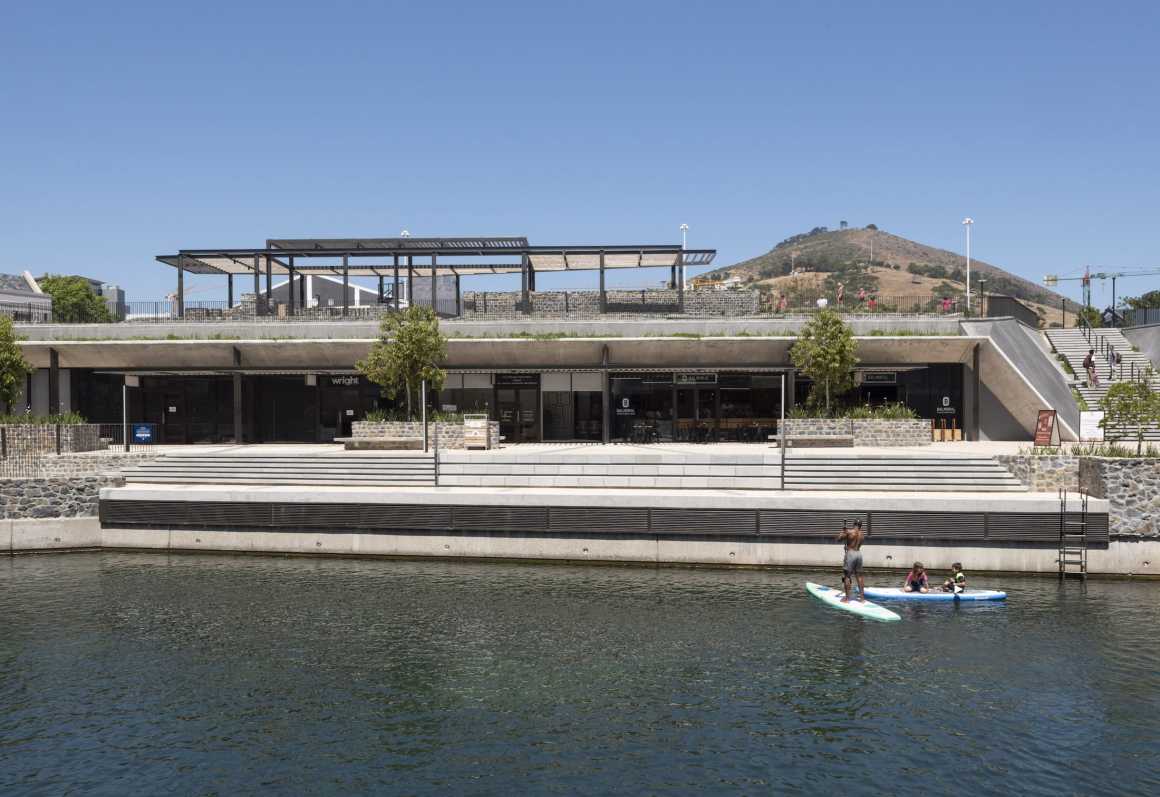
根据在尊重原有的内庭院的基础上创建低层广场的要求,我们最终创建了一个可以看到整个V&A和CBD景观的高架公园,但同时也面临着管理两个层次之间过渡的挑战。因此,巴特利公园的设计理念在很大程度上体现在打破公园与广场之间的壁垒,拉近两者之间的距离,因此,公园被设计成逐渐向运河边缘下降的形式,使其与广场更紧密地连接在一起,同时,广场也逐渐向运河下降。我们的愿景是在这两个层面之间建立尺度,并为游客提供视觉线索;当他们沿着运河边漫步时,可以瞥见公园的景色,这也是我们通过各种软硬景观元素实现的,比如从广场到公园的混凝土楼梯、倾斜和折叠的墙壁,以及吸引人们视线的公园植物。
The requirement to respect the original inner courtyard datum and create a lower-level piazza resulted in an elevated park with views across the V&A and CBD but with the challenge of managing the transition between the two levels. Therefore, a large part of Battery Park’s design concept was manifested in breaking the barrier between the park and piazza and bringing them closer to one another. As a result, the park level has been designed to gradually lower towards the canal edge providing a closer connection to the piazza, and in turn, the piazza gradually steps down towards the canal. The vision was to create scale between the two levels and provide visual cues to visitors; offering a glimpse of the park while they meander along the canal edge. This was also achieved by means of various soft and hard landscaping elements such as a grand concrete staircase leading from the piazza to the park, sloping and folding walls, and plants to draw the eye to the park above.
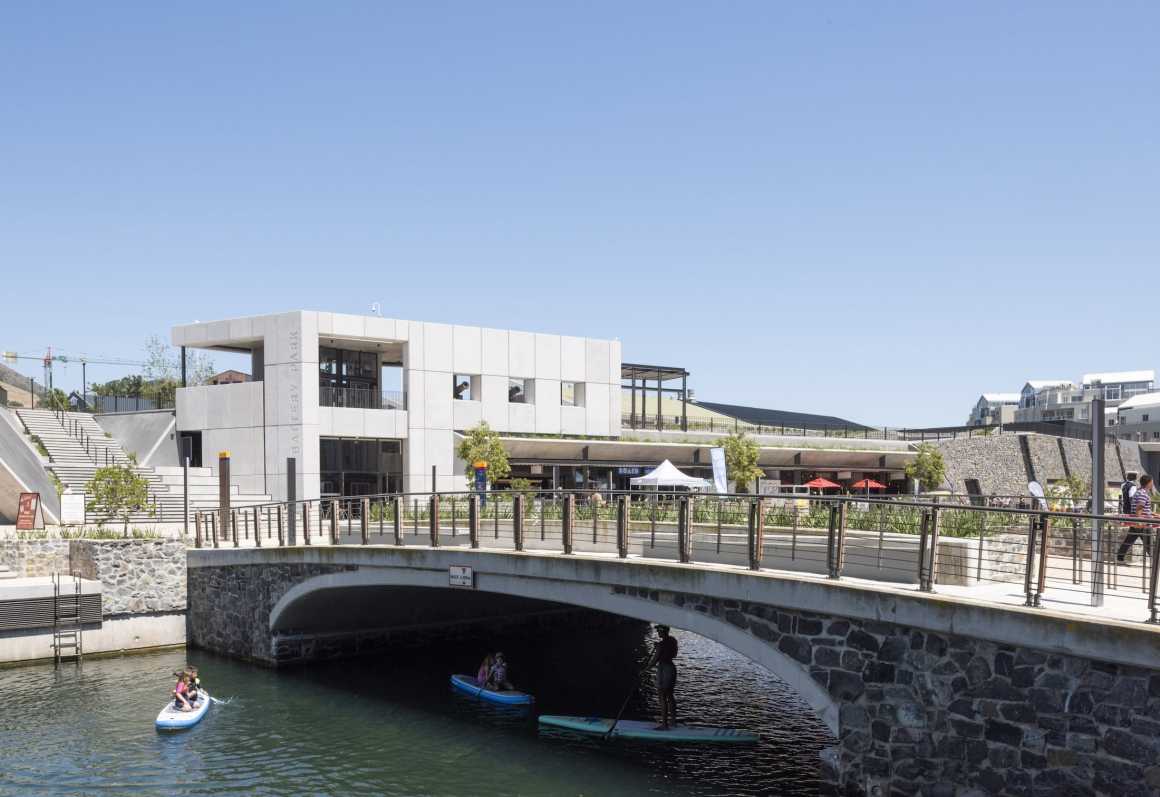
在公园的较高处,游客可以探索被树木和石头覆盖的花园、有内置长椅的蜿蜒走道、混凝土滑板公园、篮球场以及新的步行路线。整个公园和广场悬挑的钢棚架都扩大了设计规模,提供了急需的遮阳空间。
On the elevated park level, visitors can explore landscaped gardens with trees and stone-clad planters, meandering walkways with built-in benches, a concrete skatepark, basketball court and new pedestrian routes. Throughout the park and piazza cantilevered steel pergolas scale the design and provide much-needed shade.
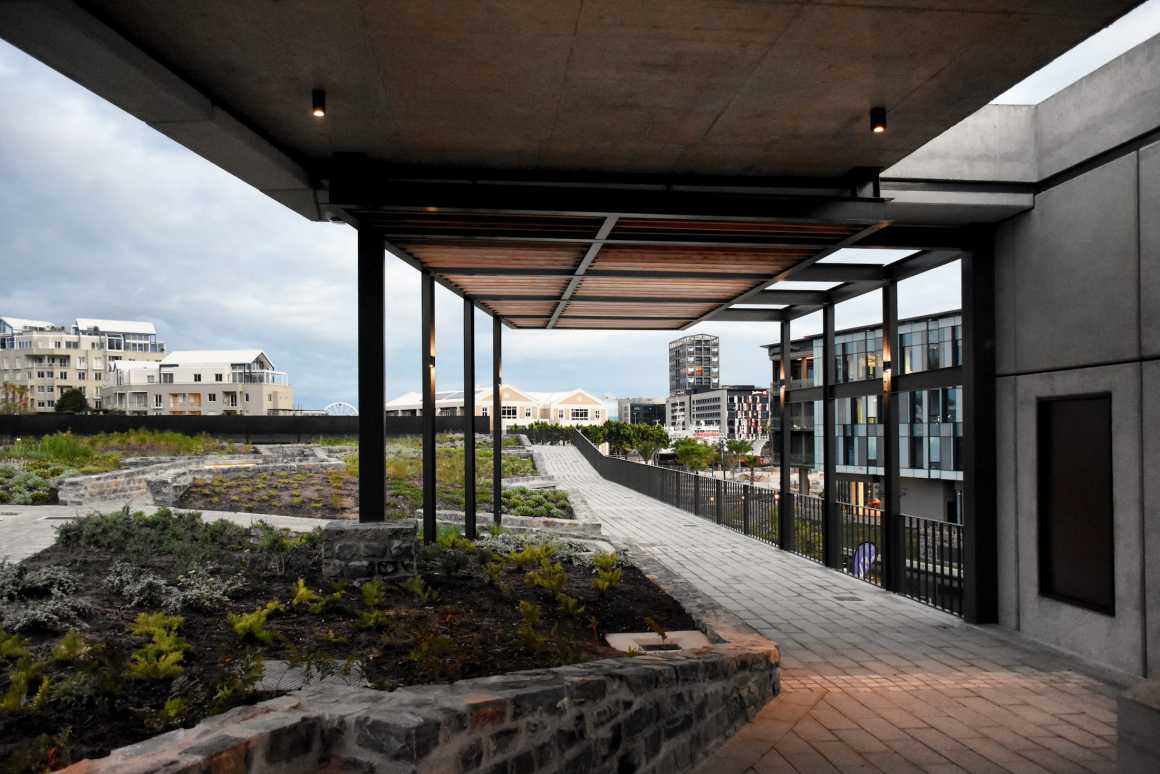
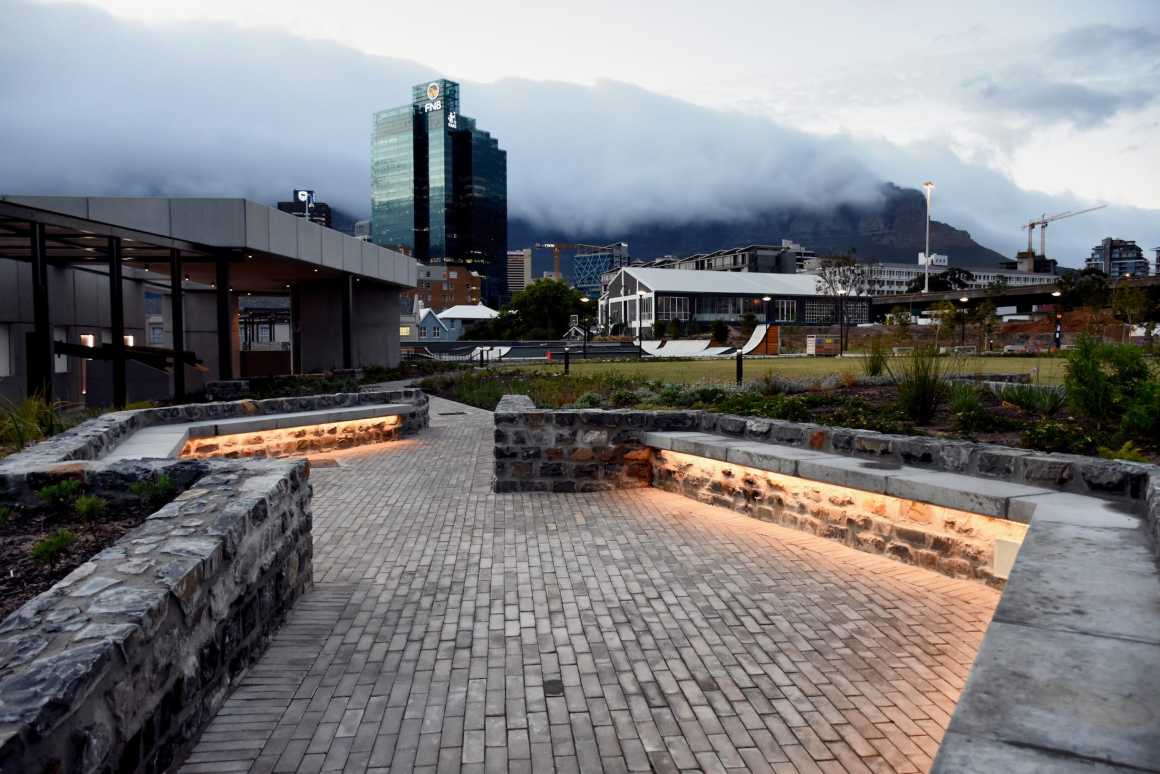
较低的广场层包含11个精品零售单元,它们沿着八字形墙壁排列,形成一条通往新运河步行路线的活跃的东部边缘。广场背后的意图是通过一系列水上运动激活运河,并在V&A和CBD之间建立联系——提倡步行环境。参照炮台的原始外观,松散堆积的石笼墙覆盖了停车设施,石笼植物包含fynbos和节水型植物,整个公园和广场使用的所有石头都是在施工过程中从现场挖掘出来的,这些古老的元素并置了当代的构筑,这些构筑物参考了炮台建筑,而不单单只是复制了它的传统。
The lower piazza level contains 11 boutique retail units that line the splayed canal-facing walls and form an active eastern edge to the new canal pedestrian route. The intention behind the piazza was to activate the canal via a range of water sports and provide a link between the V&A and the CBD – encouraging a pedestrianised environment. Referencing the battery’s original façade, loosely packed stone-filled gabion walls shroud the parking facility and stone-clad planters contain fynbos and waterwise plants. All stone used throughout the park and piazza was excavated from the site during the construction process. These antiquated elements juxtapose contemporary insertions that reference the battery rather than replicate its heritage.
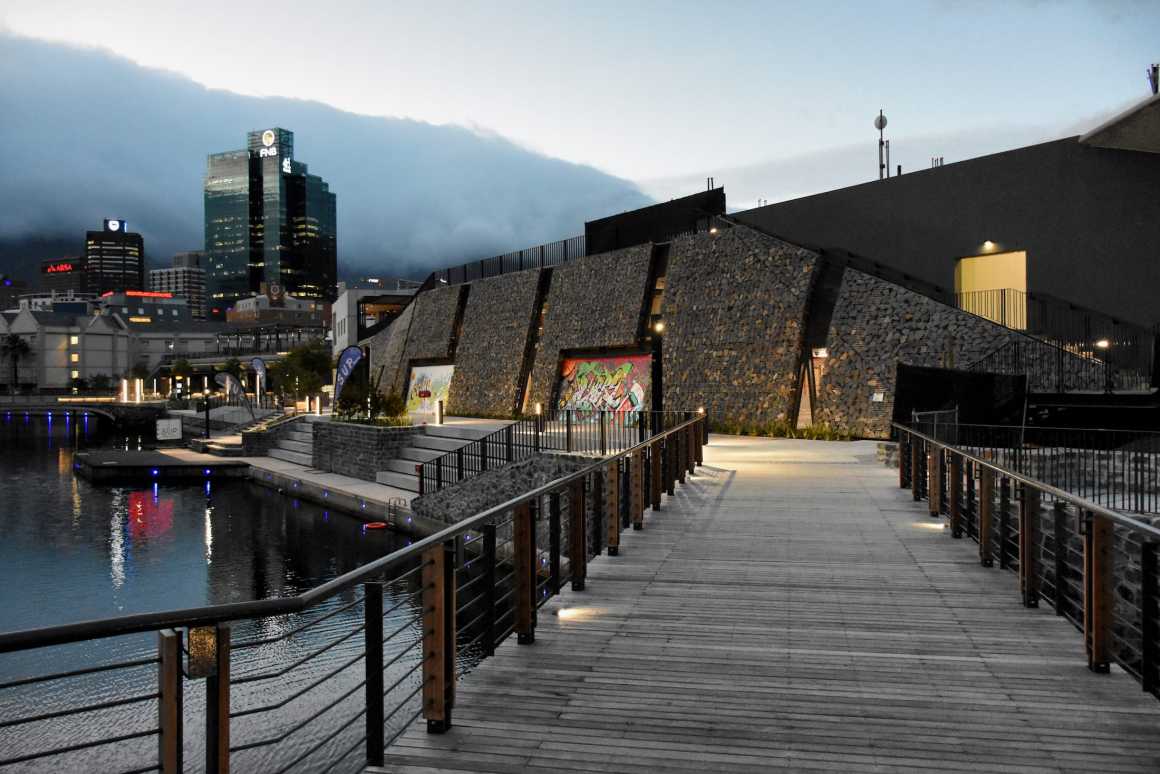
项目中的材料包括一系列符合公园坚固性的耐寒材料,即混凝土、石头和钢。混凝土被选作新建筑的“我们时代的材料”,因为它可以清楚地与历史元素区分开来,不会产生误会。一个称为“解说亭”的预制混凝土面板结构,已经造到估计与炮台原墙一样的高度,再通过内部电梯将公园、广场和停车场连接起来。为了形似大炮炮口,三个小开口也形成了该建筑面向运河的墙的一部分。
The materials palette includes a selection of hardy materials that suit the robust nature of the park, namely, concrete, stone and steel. Concrete was chosen as a “material of our time” for new structures as it can be clearly distinguished from historic elements, ensuing little misinterpretation. A precast concrete panel structure dubbed the interpretation pavilion has been built to the estimated height of the battery’s original walls and links the park, piazza and parking facility via internal elevators. To resemble cannon embrasures, three small openings form part of the structure’s canal-facing wall.

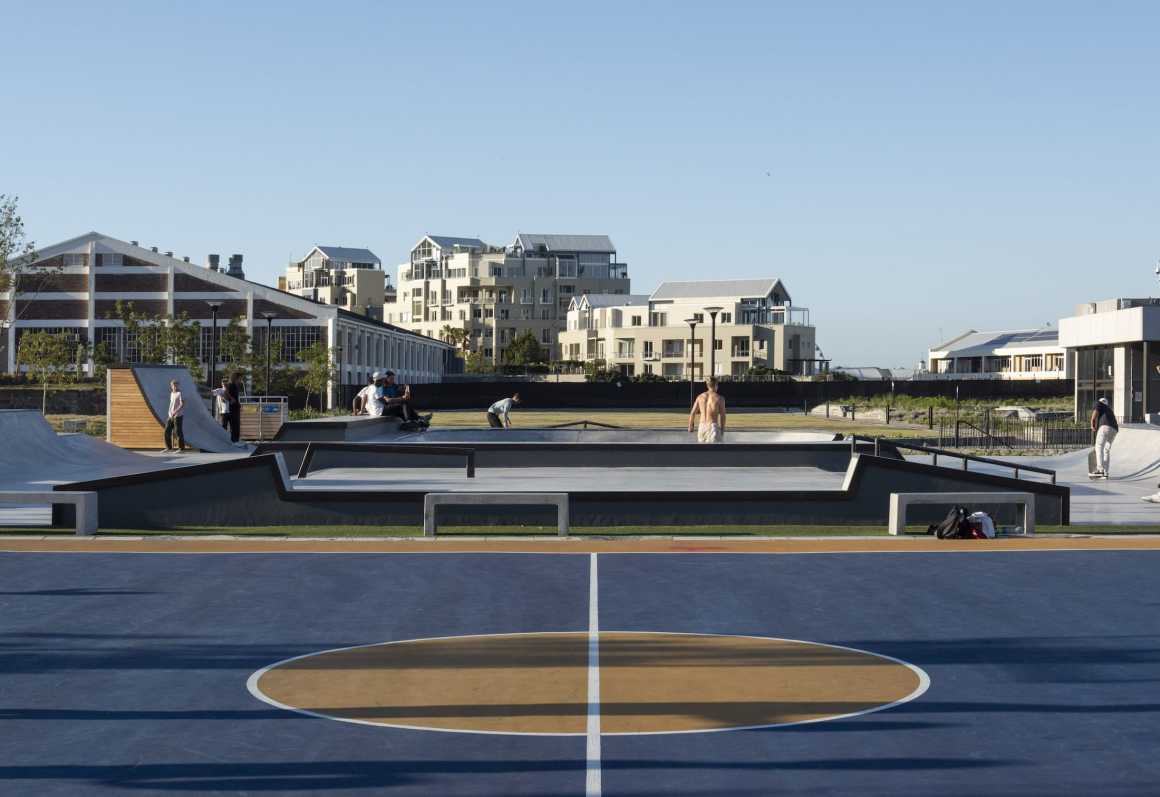
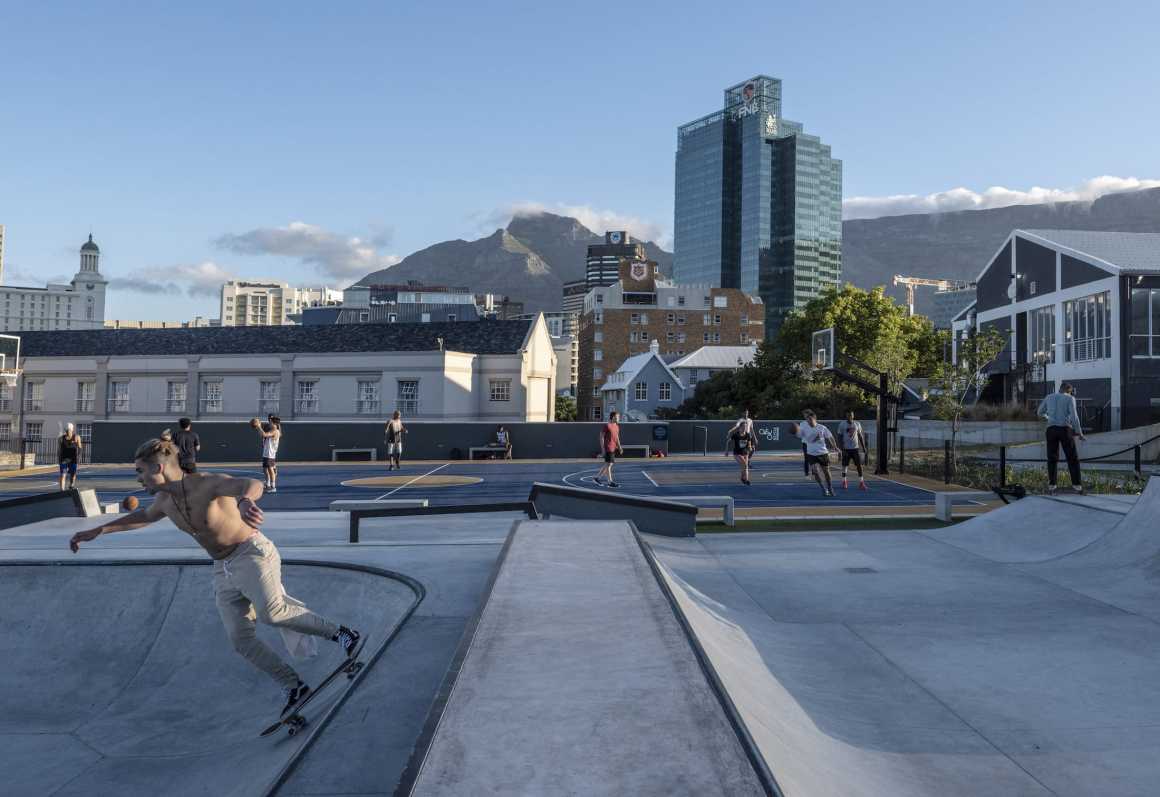
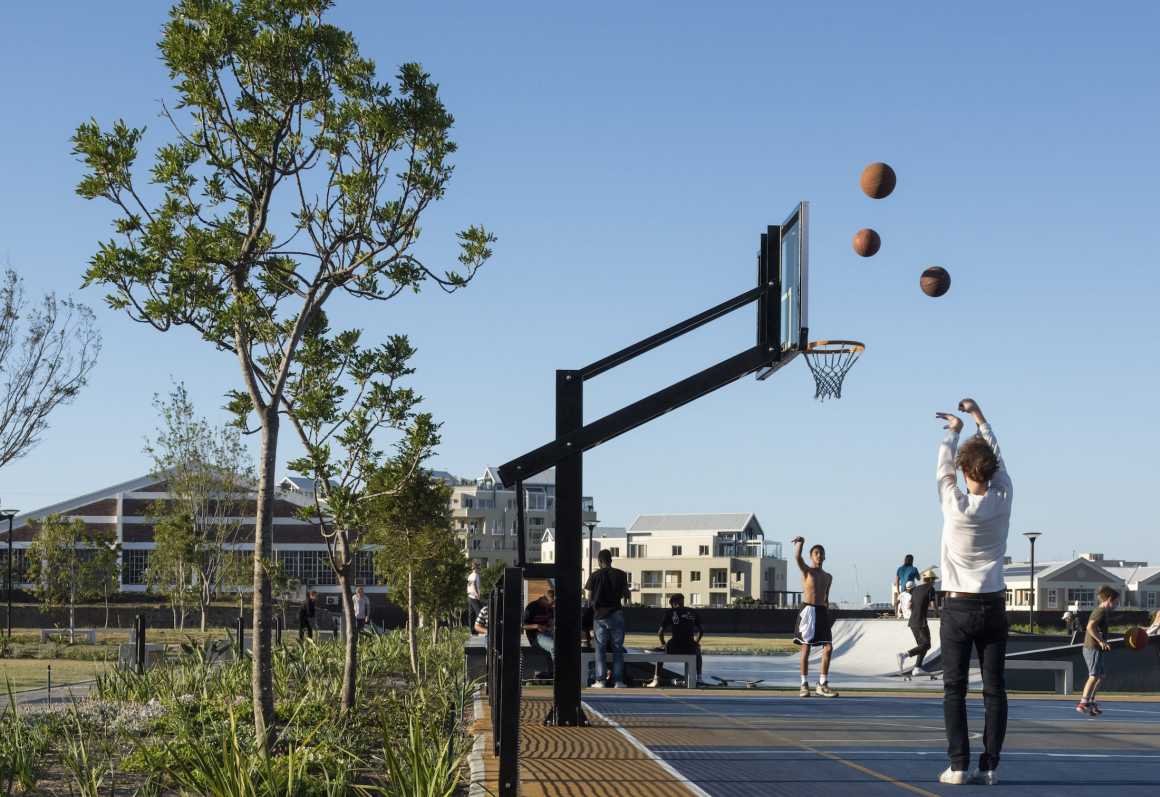
南非大炮协会发现阿姆斯特丹炮台的具有历史意义的大炮散布在 V&A各处后,将它们收集保存了下来,现在正陈列在解说馆内展出。这些人工制品坐落在预制混凝土基座上,制作得看起来像旧式木制炮架,使它们能够穿过炮眼,俯瞰运河。
Historic cannons from Amsterdam Battery found scattered throughout the V&A by the Cannon Association of South Africa and preserved for the development of the park are now on display inside the interpretation pavilion. The artefacts sit on top of precast concrete plinths, made to resemble old timber cannon carriages, allowing them to protrude through the embrasures and overlook the canal.
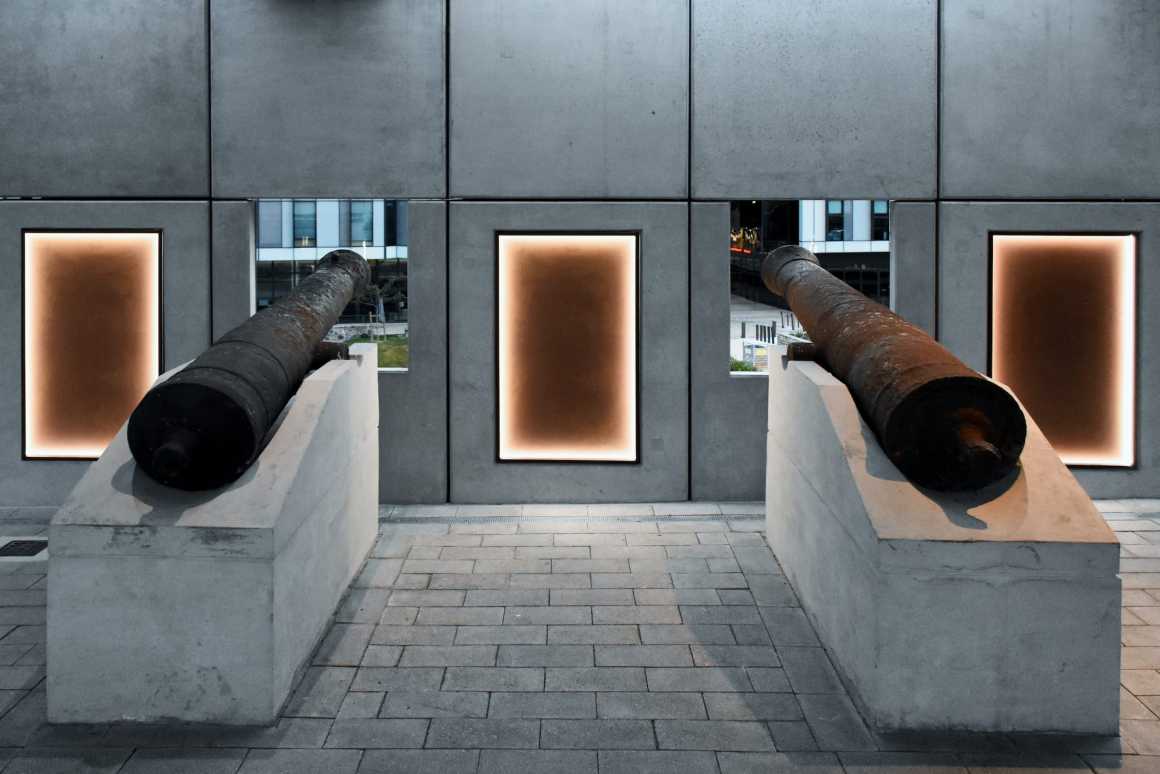
dhk董事兼项目首席建筑师Pierre Swanepoel说表示,“其目的是在尊重阿姆斯特丹炮台遗产的同时,促进V&A地区新的活动中心发展,阿姆斯特丹炮台曾经是一个被排斥和监禁的地方,但它现在是一个公共空间,旨在支持和参与更大开普敦社区的发展”。
Director at dhk and lead architect on the project Pierre Swanepoel says, “The intention was to facilitate a new hub of activity within the V&A district whilst being respectful to the heritage of the Amsterdam Battery, once a place of exclusion and incarceration, but now a public space designed to support and engage the greater Cape Town community”.
▼首层平面图 Ground floor plan
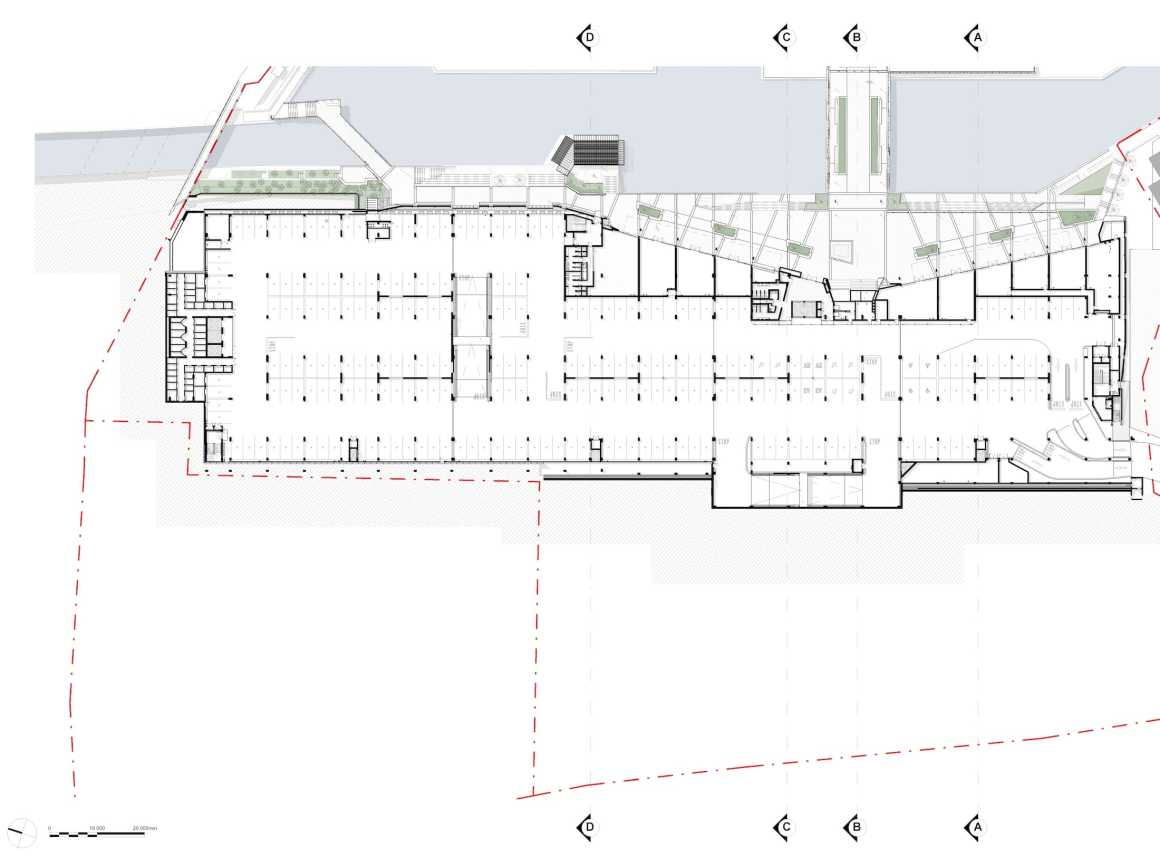
▼二层平面图 1st floor plan
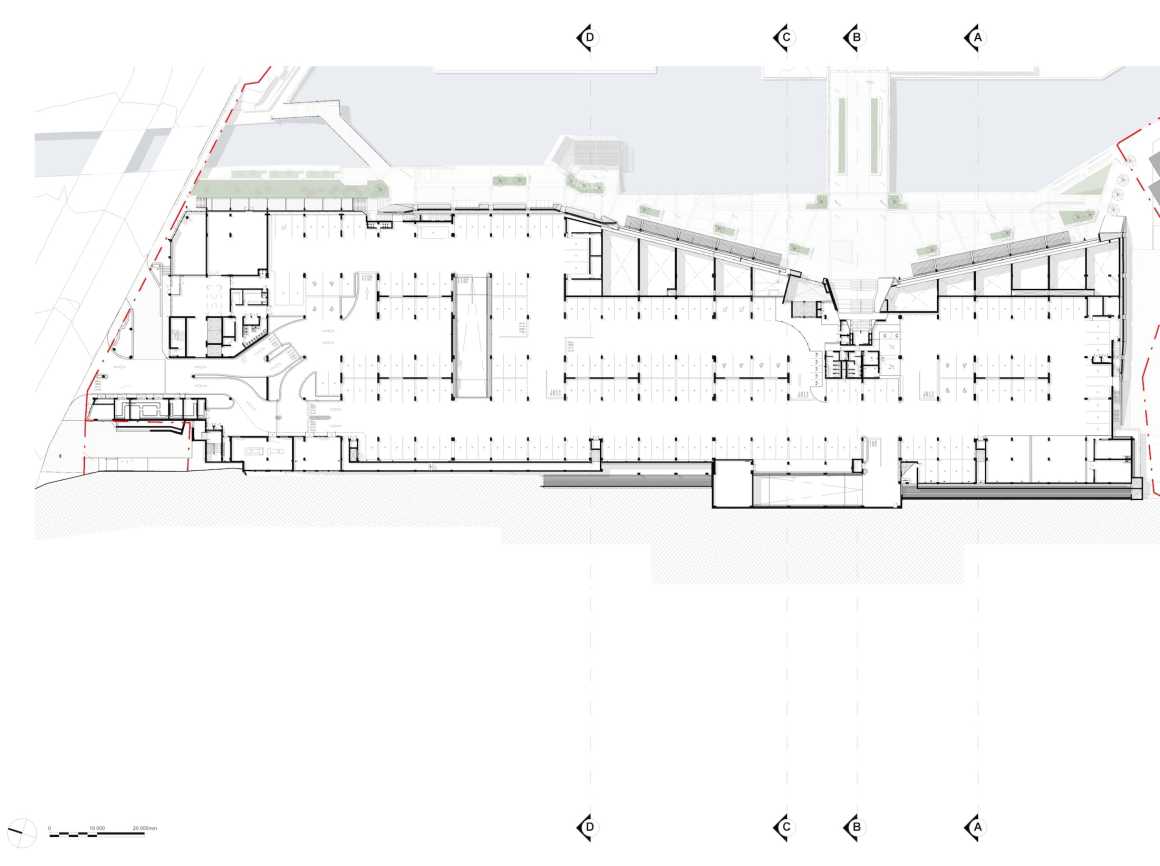
▼公园层平面 Park level

▼A-A剖面图 Section A-A

▼B-B剖面图 Section B-B

▼B-B剖面图细节 Section B-B detail

▼C-C剖面图 Section C-C

▼D-D剖面图 Section D-D

▼历史对比剖面图 Historic Overlay
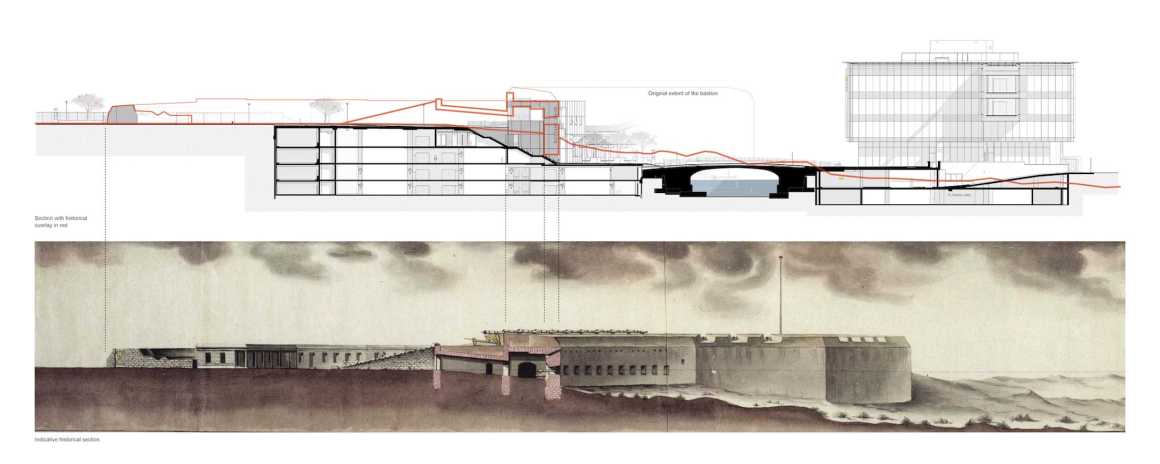
项目名称:炮台公园
项目地址:V&A滨水区 码头路
客户:V&A码头
开发人员:V&A码头
建筑设计:dhk Architects (Pierre Swanepoel, Martin Lardner-Burke, Theo Gutter)
项目经理:Igual
结构工程:LH Consulting Engineers
机械工程:Element Consulting Engineers
电气工程:Element Consulting Engineers
景观:Planning Partners
工料测量:BTKM
承包商:Group Five
顾问:Solutionstation
土地测量:Joubert & BrinkUrban
设计:dhk Architects (Guy Briggs)
声学顾问:Machoy
湿地服务顾问:Solutionstation
遗产顾问:Nicolas Baumann
考古学家:ACO associates
健康和安全代理:Eppen-burger & associates
交通工程师:GIBB, UrbanEQ
电梯顾问:Solutions for Elevating
摄影师:Dave Southwood // Theo Gutter
Project Name: Battery Park
Project Address: Dock Road, V&A Waterfront
Client: V&A Waterfront
Developer: V&A Waterfront
Architects: dhk Architects (Pierre Swanepoel, Martin Lardner-Burke, Theo Gutter)
Project Manager: Igual
Structural Engineers: LH Consulting Engineers
Mechanical Engineers: Element Consulting Engineers
Electrical Engineers: Element Consulting Engineers
Landscaping: Planning Partners
Quantity Surveyor: BTKM
Main Contractor: Group Five
Fire Consultant: Solutionstation
Land Surveyor: Joubert & Brink
Urban Designer: dhk Architects (Guy Briggs)
Acoustic Consultant: Machoy
Wet Services Consultant: Solutionstation
Heritage Consultant: Nicolas Baumann
Archaeologist: ACO associates
Health & Safety agents: Eppen-burger & associates
Traffic Engineers: GIBB, UrbanEQ
Lift Consultant: Solutions for Elevating
Photographer: Dave Southwood // Theo Gutter
更多 Read more about: dhk Architects




0 Comments